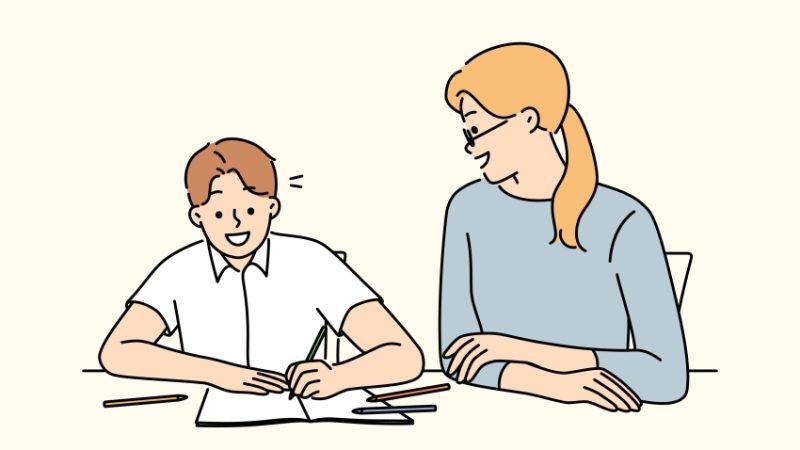How To Make Touchscreen Technology Work For You In Early Years

Many early years practitioners remain reluctant to employ touchscreens – but used properly alongside traditional approaches, they can have huge benefits to literacy development, explains Charlotte Billington…

Earlier this year, National Literacy Trust research found that there is a touchscreen device in nearly all households (97%), and that access to said technology is similarly increasing in early years settings.
However, practitioners told us that they don’t feel confident using touchscreens to support early communication, language and literacy outcomes. Our Helping Early Language and Literacy Outcomes (HELLO) project, which was funded by the Department for Education, looked at different ways technology can be used in early years settings to support practitioners.
The research
Our annual survey of early years parents and practitioners showed that:
• 97% of households have access to a smartphone or tablet device
• Access to touchscreens in early years settings has increased from 41.4% in 2014 to 58.2% in 2015
• Fewer practitioners used touchscreens to share stories in 2015 (40.8%) than in 2014 (49.1%). Of these, only half (55.1%) are confident doing so, compared to 82.2% who are confident using books
• Parents told us they are just as confident using touchscreens to share stories as they are using books (74.1% compared to 78.1%)
The practitioners who responded to the survey told us there are many different reasons why they are not confident using digital technology in their early literacy teaching. These included concerns about the size of the screen when using tablets for larger group reading activities.
Findings from the HELLO project evaluation survey meanwhile showed that practitioners have worries about children who already spend a significant amount of time using technology at home, and want to organise other activities for children while they are at the setting or children’s centre. Providing a balanced and enriching experience for children should always be a top priority. It is our view that if technology is used by confident teachers, it can benefit children’s literacy development.
A route into reading
As touchscreens and technology are relatively new in our lives, further research to analyse the impact of their presence on developing minds will take some time. The main concerns around using digital technology centre on the length of time children spend looking at screens, yet emerging studies show that technology can have a positive impact on early literacy – particularly on a child’s knowledge of the alphabet and their first attempts at writing.
Previous National Literacy Trust research has also found that technology can be a route into reading for boys and children from disadvantaged backgrounds, who are more likely than their peers to use technology for educational purposes. Along with focusing on the quantity of time children are spending with technology, we need to get better at looking at the quality of this time in supporting children’s early literacy learning. The answer to how best to use technology lies in understanding how it can be incorporated into teaching to support specific learning goals, in a way that is truly beneficial to children. Technology is not a magic bullet, but rather another tool that can be used alongside books, to support practitioners to develop children’s early communication, language, and literacy.
Quality improvement
As part of the HELLO project, the National Literacy Trust worked with over 70 PVI settings to improve early communication, language and literacy provision. This involved settings using a self-assessment and action planning tool to seek improvements across three key areas – ‘Skilled practitioners’, ‘Partnerships with parents’ and ‘Enabling environments’, in which a number of effective strategies were employed, as described below.
Skilled practitioners Settings:
• Explored good practice by working with other local settings, including peer-reviewing and providing constructive feedback
• Used video observations for staff to assess their interactions with children (you can find a template to help you do this at the National Literacy Trust website
Partnership with parents Settings:
• Established libraries within their own provision to allow families to take books or other resources, such as ‘chatterboxes’ containing communication prompts and tips for families, home;
• Invited parents along to storytelling sessions where early years teachers modelled reading to children and shared tips with mums and dads, for example, suggesting making up funny voices to improve children’s engagement;
• Provided fun activities to get families talking, for example, giving them shop signs to look out for with children on their way home.
Enabling environments Settings:
• Modelled language or displayed written signs during routines, for example, at the start of the day and at snack-time;
• Ensured books, including dual-language texts, were available during a range of activities and topics.
Settings were supported in their efforts by teaching schools and local authorities, and received peer support from other local settings, to develop these plans. Other ideas from participating settings included creating a ‘living wall’ in children’s cosy corners. which changed with the different seasons, prompting lots of conversations with children. The HELLO tool and best practice case studies with lots of other tips and ideas are all available on the National Literacy Trust website – visit literacytrust.org.uk/early-years-tech
Improve your practice
Working with early years teaching schools and local authorities on the HELLO project, the National Literacy Trust has created a range of resources to help practitioners embed technology in their teaching that you can download here. They include:
• A digital observation framework: research-based guidance for practitioners observing children’s development while they use technology, based around the Early Years Foundation Stage Development Matters milestones
• Activity sheets: tips and ideas for using different forms of technology to help develop children’s early communication, language and literacy.
• Planning sheets: termly and monthly activities with EYFS possible lines of development (PLOD) templates to help integrate technology in to teaching and learning
• Home-link sheets: to share with parents to understand how they use technology with their children at home
• Videos filmed at Harrington Day Nursery in Derby, illustrating examples of best practice in using technology in early years settings.
The National Literacy Trust also has an online guide, Literacy Apps, to help adults choose and use apps that can support early communication, language and literacy. The featured apps are grouped by age range and interest, and chosen on the basis that they can help children meet at least one of the communication, language and literacy milestones set out in the EYFS Development Matters guidance.
Charlotte Billington is the early years project manager at the National Literacy Trust; for more information, visit www.literacytrust.org.uk or follow @literacy_trust











